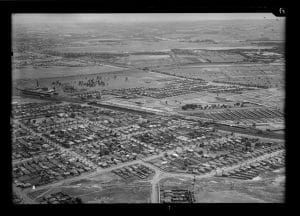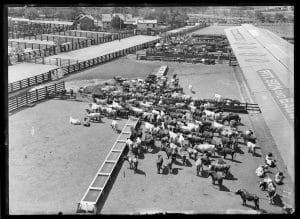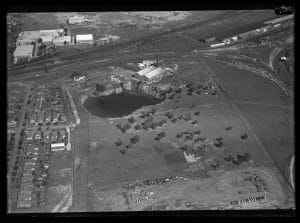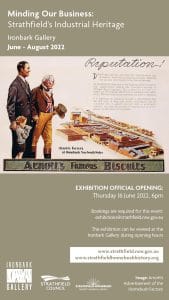Minding Our Business in Homebush West

Homebush West (Flemington), 1938 by Milton Kent. Courtesy State Library of NSW
This birds-eye view of Flemington (Homebush West) shows just how much the area has changed over the years. Formerly bordered by extensive, vacant land – now partly occupied by Sydney Olympic Park – it is hard to recognise today’s more densely populated suburb. Many of the neat cottages have been replaced by both older-style and modern apartments and thousands more people now call the suburb home.
This lovely photo also shows the sites of three of the industries featured in the Ironbark Gallery’s upcoming exhibition at Strathfield Council Library & Innovation Hub. In the middle and on the right of the photo can be seen the Homebush stockyards where thousands upon thousands of stock arrived (usually by train) to be bought and sold by various stock agents before being driven across Parramatta Road to the State Abattoir at Homebush Bay. The site of the former saleyards is now occupied by Sydney Markets. The abattoir can just be seen in the top right of the photo. In earlier days, before the abattoir was relocated, stock were driven to Glebe Island abattoir by drovers on Monday and Thursday nights – along Parramatta Road! Can you imagine the sight, smell, noise and chaos? Drovers and stock had right of way but the journeys caused great inconvenience to local residents and travellers alike.

Extract from Milton Kent, 1938 photo showing Homebush saleyards.

Homebush saleyards by Arthur Ernest Foster. Courtesy State Library of NSW
On the left of the main photo, near the middle, is a factory with a tall chimney. Formerly a brickworks, during World War II this site was bought by the industrial chemists, W. Hermon Slade. Slade contributed greatly to the war effort by inventing polymers used in army huts, motor launches, barges and even the Mosquito bomber. The company also produced chemicals used to control mosquitoes and malaria in the jungles of New Guinea. New apartments in Courallie Avenue now stand on this site.

W. Hermon Slade, Homebush West by Milton Kent, 1940s. Visible top left is the factory of Stirling Henry, textile manufacturers, also featured in the Minding Our Business: Strathfield’s Industrial Heritage exhibition. Courtesy State Library of NSW

These are just some of the many industries featured in the Ironbark Gallery’s new exhibition which will open on Thursday 16 June at 6pm. Reserve your place at the opening by emailing exhibitions@strathfield.nsw.gov.au or visit the exhibition at Strathfield Council Library & Innovation Hub between 17 June and 14 August (with the exception of 1-11 July when a NAIDOC Week exhibition will be on display) to find out more about our local industries.
By J.J. MacRitchie
